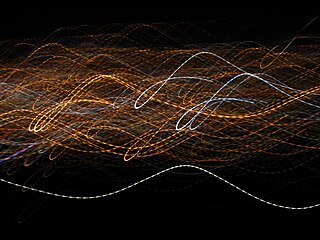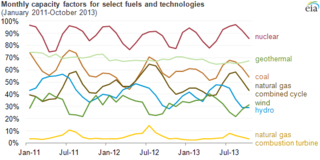The decibel is a relative unit of measurement equal to one tenth of a bel (B). It expresses the ratio of two values of a power or root-power quantity on a logarithmic scale. Two signals whose levels differ by one decibel have a power ratio of 101/10 or root-power ratio of 101⁄20.

Frequency, measured in hertz, is the number of occurrences of a repeating event per unit of time. It is also occasionally referred to as temporal frequency for clarity and to distinguish it from spatial frequency. Ordinary frequency is related to angular frequency by a scaling factor of 2π. The period is the interval of time between events, so the period is the reciprocal of the frequency, f=1/T.
In physics, power is the amount of energy transferred or converted per unit time. In the International System of Units, the unit of power is the watt, equal to one joule per second. In older works, power is sometimes called activity. Power is a scalar quantity.
In reliability engineering, the term availability has the following meanings:
In electrical engineering, the power factor of an AC power system is defined as the ratio of the real power absorbed by the load to the apparent power flowing in the circuit. Real power is the average of the instantaneous product of voltage and current and represents the capacity of the electricity for performing work. Apparent power is the product of RMS current and voltage. Due to energy stored in the load and returned to the source, or due to a non-linear load that distorts the wave shape of the current drawn from the source, the apparent power may be greater than the real power, so more current flows in the circuit than would be required to transfer real power alone. A power factor magnitude of less than one indicates the voltage and current are not in phase, reducing the average product of the two. A negative power factor occurs when the device generates real power, which then flows back towards the source.

Alternating current (AC) is an electric current which periodically reverses direction and changes its magnitude continuously with time, in contrast to direct current (DC), which flows only in one direction. Alternating current is the form in which electric power is delivered to businesses and residences, and it is the form of electrical energy that consumers typically use when they plug kitchen appliances, televisions, fans and electric lamps into a wall socket. A common source of DC power is a battery cell in a flashlight. The abbreviations AC and DC are often used to mean simply alternating and direct, respectively, as when they modify current or voltage.
Audio power is the electrical power transferred from an audio amplifier to a loudspeaker, measured in watts. The electrical power delivered to the loudspeaker, together with its efficiency, determines the sound power generated.
In electrical engineering and mechanical engineering, the power rating of equipment is the highest power input allowed to flow through particular equipment. According to the particular discipline, the term power may refer to electrical or mechanical power. A power rating can also involve average and maximum power, which may vary depending on the kind of equipment and its application.

The velocity of money measures the number of times that the average unit of currency is used to purchase goods and services within a given time period. The concept relates the size of economic activity to a given money supply, and the speed of money exchange is one of the variables that determine inflation. The measure of the velocity of money is usually the ratio of the gross national product (GNP) to a country's money supply.
In electromagnetics and antenna theory, the aperture of an antenna is defined as "A surface, near or on an antenna, on which it is convenient to make assumptions regarding the field values for the purpose of computing fields at external points. The aperture is often taken as that portion of a plane surface near the antenna, perpendicular to the direction of maximum radiation, through which the major part of the radiation passes."

In an electric circuit, instantaneous power is the time rate of flow of energy past a given point of the circuit. In alternating current circuits, energy storage elements such as inductors and capacitors may result in periodic reversals of the direction of energy flow. Its SI unit is the watt.

Capacitors are manufactured in many styles, forms, dimensions, and from a large variety of materials. They all contain at least two electrical conductors, called plates, separated by an insulating layer (dielectric). Capacitors are widely used as parts of electrical circuits in many common electrical devices.

The net capacity factor is the unitless ratio of actual electrical energy output over a given period of time to the theoretical maximum electrical energy output over that period. The theoretical maximum energy output of a given installation is defined as that due to its continuous operation at full nameplate capacity over the relevant period. The capacity factor can be calculated for any electricity producing installation, such as a fuel consuming power plant or one using renewable energy, such as wind or the sun. The average capacity factor can also be defined for any class of such installations, and can be used to compare different types of electricity production.
Ripple in electronics is the residual periodic variation of the DC voltage within a power supply which has been derived from an alternating current (AC) source. This ripple is due to incomplete suppression of the alternating waveform after rectification. Ripple voltage originates as the output of a rectifier or from generation and commutation of DC power.

The maximal total range is the maximum distance an aircraft can fly between takeoff and landing. Powered aircraft range is limited by the aviation fuel energy storage capacity considering both weight and volume limits. Unpowered aircraft range depends on factors such as cross-country speed and environmental conditions. The range can be seen as the cross-country ground speed multiplied by the maximum time in the air. The fuel time limit for powered aircraft is fixed by the available fuel and rate of consumption.

A capacitor is an electronic device that stores electrical energy in an electric field by accumulating electric charges on two closely spaced surfaces that are insulated from each other. It is a passive electronic component with two terminals.
In the context of electricity, the diversity factor is the ratio of the sum of the individual non-coincident maximum loads of various subdivisions of the system to the maximum demand of the complete system.
In electrical engineering the load factor is defined as the average load divided by the peak load in a specified time period. It is a measure of the utilization rate, or efficiency of electrical energy usage; a high load factor indicates that load is using the electric system more efficiently, whereas consumers or generators that underutilize the electric distribution will have a low load factor.

The utilization factor or use factor is the ratio of the time that a piece of equipment is in use to the total time that it could be in use. It is often averaged over time in the definition such that the ratio becomes the amount of energy used divided by the maximum possible to be used. These definitions are equivalent.
Full Load hour is a measure of the degree of utilisation of a technical system. Full load hours refer to the time for which a plant would have to be operated at nominal power in order to convert the same amount of electrical work as the plant has actually converted within a defined period of time, during which breaks in operation or partial load operation can also occur. The figure usually refers to a period of one calendar year and is mainly applied to power plants.












